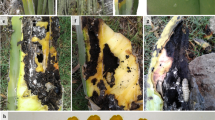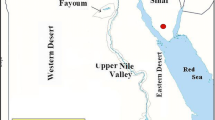Abstract
Morphological description of the pistachio weevil, Polydrusus davatchii Hoffmann, 1956, is supplemented and an additional distinctive character of the subgenus Orodrusus to which this species belongs, the strongly reduced hair brushes on the tarsal segments, is reported. Polydrusus davatchii was known as a minor pest for pistachio trees in Iran until the first decade of the XXI century, but is considered now as an important herbivore in pistachio orchards in early spring. The adults were not found on other plants in the pistachio growing areas. Only females of this species are known. Polydrusus davatchii produces one generation a year and is distributed now almost throughout the pistachio cultivation areas in central and southern parts of Iran.
Similar content being viewed by others
References
Arnoldi L.V., Ter-Minassian M.E. & Solodovnikova V.S. 1974. Sem. Curculionidae - dolgonosiki [Fam. Curculionidae - weevils], pp. 218–293. In: Kryzhanovskiy O.L. (ed.), Nasekomye i kleshchi - vrediteli sel’skokhozyaistvennykh kul’tur [Insects and Mites Injurious to Agricultural Crops], Vol. 2, Nauka, Leningrad, 336 pp.
Broumand H. 1998. Insects of Iran. The List of Coleoptera in the Insect Collection of Plant Pests & Diseases Research Institute. Coleoptera (XXIV), Curculionoidea (Anthribidae, At-telabidae, Brentidae, Apionidae, Curculionidae, Scolytidae, Platypodidae). Fam. 162, pp. 166–171. Plant Pests & Diseases Research Institute, Insect Taxonomy Research Department, Publ. No. 2, Tehran, Iran, 110 pp.
Hofmann A. 1956. Curculionides nouveaux rapportés par la Mission G. Remaudière en Iran. Revue de Pathologie Végétale et d’Entomologie Agricole de France 34: 241–249.
Jashenko R.V. & Zyuzin A.A. 2000. O neobkhodimosti adek-vatnogo ispoľzovaniya nazvani>i Srednyaya Aziya i Tsentraľ-naya Aziya [On the necessity of adequate use of the names Middle Asia and Central Asia]. Tethys Entomological Research, Kazakhstan, Almaty 2: 5–6.
Konstantinov A.S., Korotyaev B.A. & Volkovitsh M.G. 2009. Insect biodiversity in the Palearctic Region, Chapter 7, pp. 107–162. DOI: https://doi.org/10.1002/9781444308211.ch7. In: Foottit R. & Adler P. (eds), Insect Biodiversity: Science and Society, 1st edn, Blackwell Publishing, Oxford, United Kingdom, 632 pp. DOI: https://doi.org/10.1002/9781444308211. ISBN: 9781405151429
Korotyaev B.A. & Meleshko Zh.Ye. 1995. Osobennosti raspros-traneniya partenogeneticheskikh dolgonosikov na primere Polydrusus inustus Germar, 1824 i P. pilifer Hochhuth, 1847 (Coleoptera, Curculionidae) [Characteristic features of the distribution of parthenogenetic weevils with Polydrusus inustus Germar, 1824 and P. pilifer Hochhuth, 1847 (Coleoptera, Curculionidae) as examples], Trudy Zoologich-eskogo muzeya Belorusskogo goosudarstvennopgo univer-siteta, Minsk) [Fauna and Systematics (Proceedings of the Zoological Museum of the Byelorussian State University. Minsk)] 1: 213–227.
Korotyaev B.A. & Meleshko J.Ye. 1997. On the systematics of the weevil genus Polydrusus (Coleoptera: Curculionidae). Zoosys-tematica Rossica 6(1/2): 275–286.
Legalov A.A., Ghahari H. & Arzanov Yu.G. 2010. Annotated catalogue of curculionid-beetles (Coleoptera: Anthribidae, Rhyn-chitidae, Attelabidae, Brentidae, Brachyceridae, Dryoph-thoridae and Curculionidae) of Iran. Amurian Zool. J. 2(3): 191–244.
Lukjanovitsh F.K. & Ter-Minassian M.E. 1955. Sem. Curculion-idae - dolgonosiki, ili sloniki [Fam. Curculionidae - weevils], pp. 592–648. In: Pavlovski>i E.N. (ed.), Vrediteli lesa [Forest Pests], Vol. 1, 2. Izd. AN SSSR, Moscow-Leningrad, 971 pp.
Medvedev L.N. 1982 Listoedy MNR: Opredelitel’ [Leaf Beetles of MPR: (Mongolian People’s Republic): Identification Key]. Nauka, Moscow, 303 pp.
Medvedev G.S. 2005. On connections of the sand desert faunas of Tenebrionidae (Coleoptera) of Middle Asaia, Iran, and Afghanistan, pp. 299–314. In: Konstantinov A., Tishechkin A. & Penev L. (eds), Contributions to Systematics and Biology of Beetles, Papers Celebrating the 80th Birthday of Igor Kon-stantinovich Lopatin, Pensoft, Sofia, Moscow, 450 pp. ISBN: 9546422339
Mehrnejad M.R. 2001. The current status of pistachio pests in Iran. Cahiers Options Méditerranéennes Ser. A: Séminaires Méditerranées 56: 315–322.
Mehrnejad M.R. 2014. The Pests of Pistachio Trees in Iran, Natural Enemies and Control. Sepehr Publ., A. Rezvani (ed.), Tehran, Iran, 272 pp. [In Persian] ISBN: 978-600-6200-16-3
Meleshko J.E. & Korotyaev B.A. 2005. Two new species of the weevil genus Polydrusus Germar (Coleoptera: Curculion-idae: Entiminae) from Southern Iran, pp. 289–297. In: Konstantinov A., Tishechkin A. & Penev L. (eds), Contributions to Systematics and Biology of Beetles, Papers Celebrating the 80th Birthday of Igor Konstantinovich Lopatin, Pen-soft, Sofia, Moscow, 450 pp. ISBN-10: 9546422339, ISBN-13: 9789546422330
Southwood T.R.E. 1978. Ecological Methods with Particular Reference to the Study of Insect Populations. 2nd Ed., Chapman and Hall, London, 524 pp. ISBN-10: 0470264101, ISBN-13: 978-0470264102
Thompson R.T. 1992. Observations on the morphology and classification of weevils (Coleoptera, Curculionoidea) with a key to major groups. J. Nat. Hist. 26(4): 835–891. DOI: https://doi.org/10.1080/00222939200770511
Velázquez de Castro A.J. 2002. The terminology of metendoster-nite in Coleoptera. Elytron [2001] 15: 191–194.
Velázquez-de-Castro A.J., Gharali B. & Korotyaev B.A. 2014. Polydrusus nadaii Meleshko & Korotyaev, a possible new pest for Pistachio trees in Iran (Coleoptera, Curculionidae, Entiminae). Bull. Soc. Entomol. Fr. 119(3): 315–318.
Yunakov N.N. 2013. Tribe Polydrusini Schoenherr, 1823, pp. 364–375. In: Löbl I. & Smetana A. (eds), Catalogue of Palaearctic Coleoptera, Vol. 8, Curculionoidea II, Brill, Leiden, 700 pp. ISBN-13: 9789004252066
Author information
Authors and Affiliations
Corresponding authors
Rights and permissions
About this article
Cite this article
Mehrnejad, M.R., Meleshko, J.Y. & Korotyaev, B.A. Morphological description and observations on the biology of Polydrusus davatchii (Coleoptera: Curculionidae: Entiminae), a pest of pistachio trees in Iran. Biologia 72, 1067–1074 (2017). https://doi.org/10.1515/biolog-2017-0116
Received:
Accepted:
Published:
Issue Date:
DOI: https://doi.org/10.1515/biolog-2017-0116




